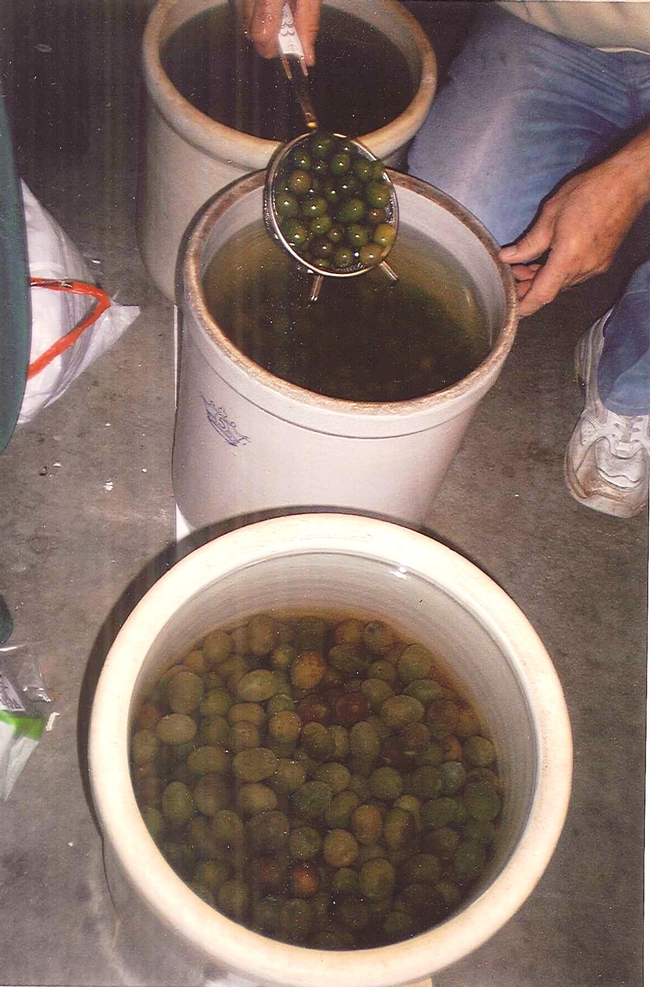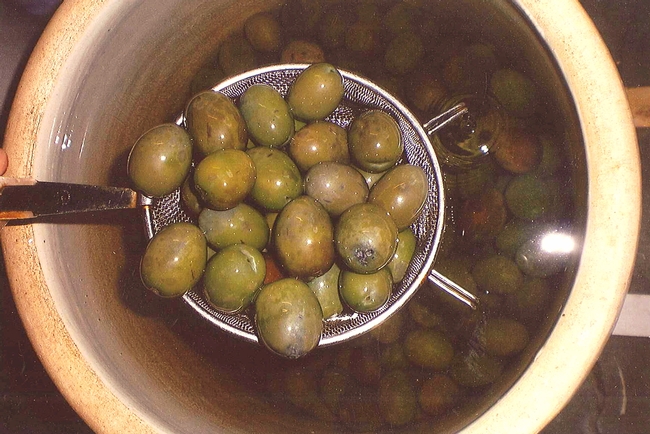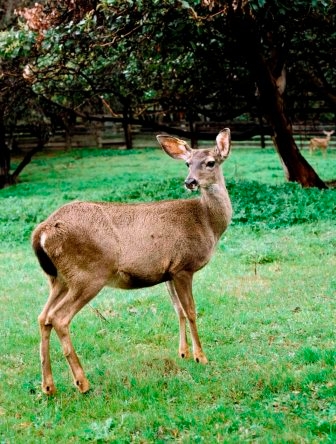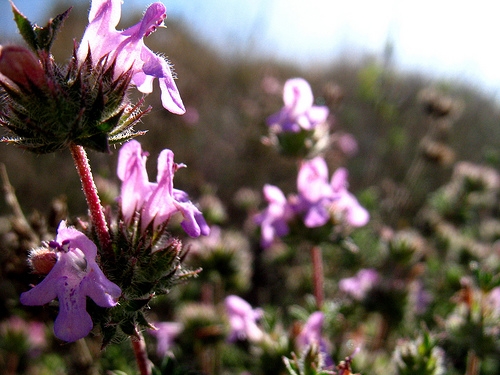UC Blogs
Italian Olives
This fall the search for olives began. As my husband and I drove around Solano County, we noticed the barren olive trees. Olives are like many other fruits, they have good production years and not so good years. The unpredictable weather this past spring most likely affected fruit set.
Curing olives is a yearly Italian heritage tradition at our house. My husband’s grandfather and mother cured olives, so the family would have olives to eat and cook with during the holidays. Before meeting my husband, I thought olives were a table decoration, then learned they were a whole food and could be a WHOLE meal. In Italy, olives are found in barrels at the front door of grocery stores and also peddled on the streets wrapped in newspaper shaped into a cone.
In the past, we have picked olives on the property of our friends or family. Last year, we bought them in Oroville and this year they came from Corning. The olives this year are beautiful, large and shiny green. The type of olive my husband cures is called a Sevillano olive (Sicillian-style). Olives on the tree, at any stage of ripeness, are very bitter and inedible because of the oleuropein that is abundant in its flesh. The curing process removes the bitterness. There is quite a science to curing olives and definitely a time commitment. Once we obtain olives, the next 7 to 10 days are about preparing them to be eatable. When the curing process ends, they are bottled and pressured canned. In the past, he has seasoned them with fresh rosemary, garlic cloves, celery, red pepper flakes and even added vinegar. There are many ways to change the flavor, but our preference is leaving them plain in salted water.
There is great information available on the web from UC Davis, on safe methods for curing olives (Publication #8267). It takes a lot of time and is a lot of work, but we know our holidays will be celebrated again this year with delicious, home-cured Italian olives; a labor of love!
Honey of an Event!
If you missed the Honey! event sponsored by the Robert Mondavi Institute for Wine and Food Science and held recently in the UC Davis Conference...
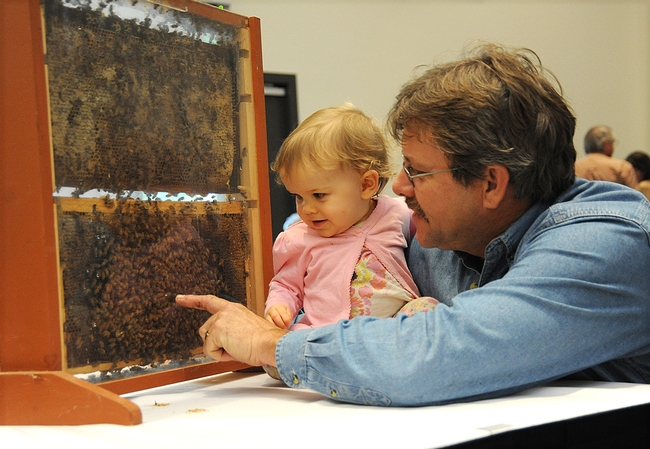
Future beekeeper Emily Fishback with her beekeeper-father Brian Fishback of Wilton, who provided the bee observation hives. (Photo by Kathy Keatley Garvey)
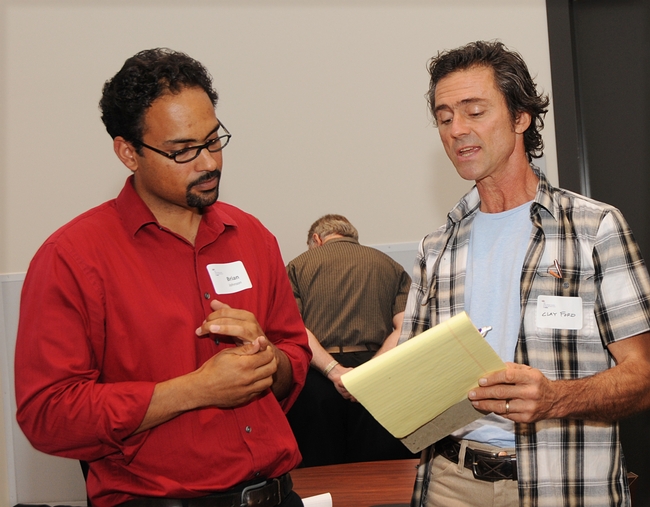
UC Davis assistant professor Brian Johnson (left) answers a question from beekeeper Clay Ford of Vacaville. (Photo by Kathy Keatley Garvey)
Reducing roadkill on freeways
Researchers are hoping a project that includes capturing and tracking deer will reduce roadkill on Interstate 280, outside San Francisco.
UC Davis researchers and state Department of Fish and Game officials are capturing deer between Dec. 2 and Dec. 15 along a stretch of the freeway from Millbrae to Woodside, said Fraser Shilling (video clip), head of the research project and co-director of the Road Ecology Center at UC Davis.
Using tranquilizer darts fired from a rifle, or "clover traps" (large netting enclosures), about 15 deer are expected to be captured. Researchers plan to capture another 30 deer by the time the project is completed in May 2013.
The deer would be "minimally disturbed" by the darts or enclosures, with the worst harm being from falling down, according to Shilling.
"That's the level of harm," he said. "There's no long-term damage to it."
The captured deer will be fitted with GPS collars that will record their location and send the information to researchers who will use the data to track the deer as they move along the areas adjoining the freeway, or onto the roadway itself.
Timers will automatically release the collars after six months, Shilling said.
Besides tracking the deer, researchers will also use 40 wildlife cameras to capture images of wildlife and map the locations of road kill. The information will be used to make a recommendation to determine what kind of strategies could be used to reduce the number of collisions between deer and other animals on the freeway.
Deer grazing along the side of the freeway and dead deer on the shoulder are common sights along the roadway, which runs through mostly heavily-wooded areas, rolling hills, and grasslands between San Francisco and San Jose.
The deer study, funded by a $320,000 grant through the federal Transportation Enhancement program, will be used to try to reduce the number of collisions between cars and deer on the freeway.
Every year, about 300,000 collisions occur nationwide between vehicles and wildlife, resulting in 200 deaths and 26,000 injuries. The costs associated with deer strikes alone add up to $8.5 billion annually.
Road Ecology Center at UC Davis
“Road ecology” is emerging as an environmental science focusing on the impact of roads on nature, such as how plant and animal populations are fragmented by roads, and how vehicle noise and pollution negatively impact animals and plants.
An understanding of road ecology also allows transportation planners to optimize mobility while minimizing the adverse impact of roads and vehicles.
The UC Davis Road Ecology Center brings together policy makers from transportation and environmental settings to design sustainable transportation systems that complement the needs of natural landscapes and human communities.
Some of the organizations partnering with the Road Ecology Center on projects include Caltrans, the California Department of Fish and Game, the UC Davis Sustainable Transportation Center, the John Muir Institute of the Environment and the Institute of Transportation Studies at UC Davis, and Defenders of Wildlife.
Citizen science
A “citizen science” component of the Road Ecology Center is the California Roadkill Observation System, a statewide roadkill reporting website for people to record their observations of dead animals and their environmental context. The information will be used to reduce the number of roadkill incidents.
The top 5 species of animals killed on California roads and highways are raccoon, striped skunk, California ground squirrel, Virginia opossum, and mule deer (or black-tailed deer).
Savor the Za'atar
What is this mysterious ingredient that Michael Symon and other Iron Chefs are talking about when they refer to Za'atar. I am usually watching the foodie shows in the evening and the question soon fades away only to resurface another evening when a Mediterranean dish is being prepared. By happenstance I recently attended a plant sale and spied an herb marked "Za'atar". Ok, finally I am to find out what the fuss is about with this herb. The plant is labelled Satureja thymbra aka 'Pink Savory Za'atar' of the Laminaceae (mint family) a perennial that grows to 12 " likes sun, is a mid-Eastern spice with the delicious flavor of oregano, thyme and mint and the plant prefers hot dry areas. Great, I have just the garden space in my new perennial garden. Almost alright, I next go to Google to corroborate this new information. I find confusion with my results, is Za'atar an herb as mine was labelled, or is it a spice mixture similar to a curry mixture?
I find that Za'atar has references both as a spice mixture and an herb. The herb Origanium syriacum appears to be the true za'atar with hyssop, Satureja thymbra, the genus of tender, thyme-like plants (Thymbra spicata, t. capitatus) also referred to as Za'atar. The common denominator with these plants is the aroma of oregano from the chemical carvacrol.. The Za'atar spice blends include oregano or thyme or both. So, as is frequently the case, with too much information I have to make a choice. I am going to stay with my local source and I will grown the herb, Satureja thymbra in my garden and call it Za'atar. This evergreen perennial is native to the Mediterranean and is a dominant plant on the island of Crete. It flowers in the spring with large pink flowers and the bush is highly aromatic and imparts a spicy flavor. Here in zone 9b we are very lucky to share the Mediterranean climate that allows many plants to thrive as perennials with the lovely benefit of year round herb gardens. Maybe, I'll send off a question to Alton Brown on this subject and let him tackle this subject and see how he does.
Residents feel left out of Delta planning
Residents around the Sacramento-San Joaquin River Delta feel left out of the decision-making process over a local water conservation plan, University of California researchers learned by conducting "conversations" in five counties last year. Tim Hearden of Capital Press spoke to two of the UC Cooperative Extension advisors involved in hosting and evaluating the conversations, Jodi Cassell and Shelly Murdock of Contra Costa County.
Residents repeatedly said experts and policymakers gave their points of view at public meetings about a water conservation plan that could include a peripheral canal, but they didn't seem to absorb the public's perspective.
"I'm a scientist and I work on ecological things ... but you really have to work with the communities to get their buy-in to the lands you want to restore," Cassell said. "When you go to a public meeting and there are maps on the table or documents showing your property ... it gets people's dander up."
University researchers produced a 4-page report and a 13-minute video containing some of the comments made at the meetings, and plan to share the views with policymakers.
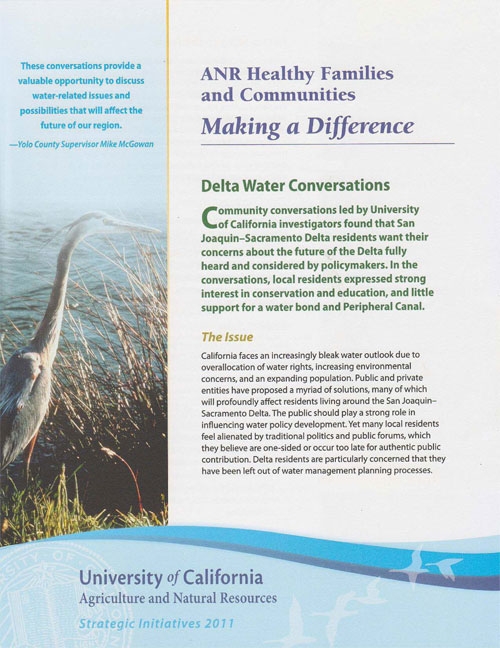
ConversationReport


